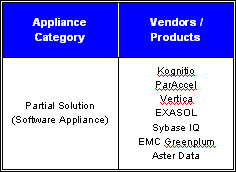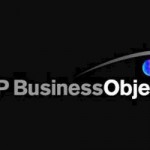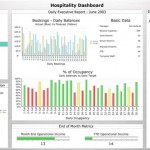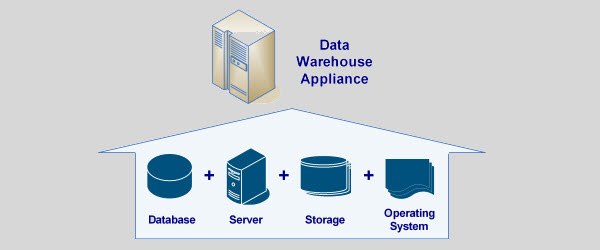
- Data warehouse appliances are purpose-built data warehouse solutions and systems that encompass a whole-technology stack including:
- • Operating System (OS)
- • Database Management System (DBMS)
- • Server Hardware
- • Storage Capabilities
- Data warehouse appliances can be broken down into three main categories:
- • Complete Data Warehouse Solutions
- • Partial Data Warehouse Solutions / Software Appliances
- • General Data Appliance / Complimentary Database Engine
Complete Data Warehouse Solutions
Initially DW appliances were created with proprietary custom-built hardware and storage units. Netezza, Teradata, DATAllegro, & White Cross (now Kognito) were the first vendors to provide solutions in this manner. Subsequently data warehouse appliances evolved and started to utilize lower-cost, industry-standard non-proprietary hardware components.The movement from proprietary to commodity hardware has proven to bring down the cost of the data warehouse appliance as the commodity hardware can integrated at a lower cost of both developing and integrating proprietary hardware. Examples of commodity hardware typically include general-purpose servers from Dell, Hewlett Packard (HP), or IBM utilizing Intel processors and popular network and storage hardware from either Cisco, EMC, or Sun.
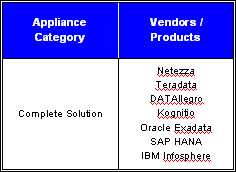 Introduced 2002, Netezza was the first vendor to offer a complete data warehouse appliance, so early definitions of appliance were based upon Netezza products. Subsequently, Netezza Performance Server still provides all of the software components of a data warehouse appliance, including the database, operating system, servers, and storage units. However in 2009, Netezza replaced its own proprietary hardware with IBM blade servers and storage units. Further in 2010, IBM completed a corporate acquisition of Netezza.
Introduced 2002, Netezza was the first vendor to offer a complete data warehouse appliance, so early definitions of appliance were based upon Netezza products. Subsequently, Netezza Performance Server still provides all of the software components of a data warehouse appliance, including the database, operating system, servers, and storage units. However in 2009, Netezza replaced its own proprietary hardware with IBM blade servers and storage units. Further in 2010, IBM completed a corporate acquisition of Netezza.
Similar to Netezza, DATAllegro was launched in 2005 with a complete solution involving proprietary hardware. Soon after DATAllegro replaced its own proprietary hardware with commodity server from Dell and storage units from EMC. In 3008, Microsoft acquired DATAllegro in 2008 and announced it will integrate DATAllegro’s massive parallel processing (MPP) architecture into its own MS SQL Server platform, which also runs on commonly-available hardware.
Additionally, both Kognitio and Teradata replaced their proprietary hardware within their appliances in a process similar to that of DATAllegro. Kognitio now offers a row-based, in-memory database database called WX2 that does not include indexes or data partitions and runs on blade servers from IBM and Hewlett-Packard. Teradata provides a proprietary database, a variety of common operating systems (Linux, Unix, and Windows), and a proprietary networking subsystem packaged along with commodity processors and storage units.
Announced at the 2008 Oracle OpenWorld conference in San Francisco, the Oracle Exadata Database Machine is a complete package of database software, operating system, servers, and storage. The product was initially assembled in collaboration between Oracle Corporation and Hewlett Packard where Oracle developed the database, operating system and storage software, while HP constructed the hardware. However, with Oracle’s acquisition of Sun Microsystems, Oracle announced the release of Exadata Version two with improved performance and usage of Sun Microsystems storage and operating systems technologies.
At the Sapphire conference in May, 2010 in Orlando, SAP announced the release of its new data warehouse appliance called HANA or High-Performance Analytic Appliance. SAP HANA is a combination of hardware, storage, operating system, management software, and in-memory data query engine that is characterized by data being held in RAM rather than being read from disks or flash storage.
Finally IBM bundles and integrates its own Infosphere Warehouse database software (formerly “DB2 Warehouse”) with its own servers and storage to deliver the IBM Infosphere Balanced Warehouse.
Partial Data Warehouse Solutions – Software Appliances
Starting in 2006, a new wave of vendors emerged that focus on database management systems (DBMS) purpose-built for data warehousing that easily integrate with another vendor’s hardware. The products from these “partial-solution” data warehouse appliance vendors have been coined as “software appliances”. The software appliance has proved to be a good starting point for new data warehouse vendors. It allows them to focus on their strength, database software, and to partner with commodity hardware vendors and benefit from the hardware firms’ focus and resources.
- The partial solution vendor is typically a software company that has developed a proprietary database and either partners with or is a subsidiary of one or more major hardware vendors. These software vendors generally focus on the development of an optimal database management software that is suitable for large data warehouse implementations, and commonly rely on other vendors to supply the most-appropriate hardware.
Software appliance vendors with products based upon the traditional row-based database model:
- Kognitio – Offers a row-based “virtual” database called WX2 that does not include indexes or data partitions and runs on blade servers from IBM and hardware from Hewlett-Packard. Kognitio can be deployed to a customer in one of three ways: as a software-only license solution, as a fully configured data warehouse appliance, and on-demand via a Data Warehousing as a Service (DaaS) offering.
Software appliance vendors with products based upon the columnar database model in which data is stored in columns rather than rows:
- ParAccel – The ParAccel Analytic Database is a proprietary column-based database that combines patent-pending innovations with a columnar, compressed, massively parallel, all-in-memory-capable architecture. The database is available as a packaged appliance on Sun hardware known as Ultra-Fast Data Warehouse powered by Sun and ParAccel.
- Vertica – The Vertica Analytic Database is a grid-based, column-oriented database that runs on grids of commodity Linux-based servers. It features column-oriented storage organization, compression, hybrid storage organization, and a shared nothing architecture. In March 2011, Hewlett Packard (HP) completed an acquisition of Vertica Systems, Inc.
- EXASOL – Offers a proprietary, massively parallel database management system called EXASolution. The product is column-based and makes extensive use of in-memory processing. Join indexes are automatically generated at run-time, as required. EXASolution is available either as a software only solution or as a pre-configured appliance running on commodity hardware such as Fujitsu Siemens, HP, Supermicro or Hitachi. EXASolution uses its own version of Linux which provides extended capabilities to support its clustered architecture.
- Sybase IQ – Distinguishes itself from conventional databases with its column-oriented, grid-based architecture, patented data compression, and advanced query optimizer. Sybase IQ provides significantly faster query performance than traditional database environments which were designed primarily for processing transactions. The improvement over such solutions can be 10 to 1000 times greater, even as thousands of users and years worth of data are added to the environment. Announced in May 2008, Sybase Analytical Appliance combines pSeries hardware from IBM with the Sybase IQ database.
Software appliance vendors with products based upon a hybrid row and column database:
- EMC Greenplum – Acquired in July 2010 by EMC, Greenplum has become the foundation of EMC’s Data Computing Division. Moreover, the EMC Greenplum database contains a shared-nothing, massively parallel processing (MPP) architecture that has been purpose-built for business intelligence and analytical processing.
- Aster Data – Provides a database management system (DBMS) called Aster Data nCluster, which is a massively parallel (MPP) hybrid row and column database with an integrated analytics engine. Aster Data’s solution utilizes Aster Data’s patent-pending SQL-MapReduce to allow for parallel processing of data and applications and to deliver rich, analytic insights. Aster Data products can be deployed to a customer in one of three ways: Software-only, Cloud-based, and Complete-appliance called Aster Data MapReduce DW Appliance. In April 2011, Teradata completed its acquisition of Aster Data Systems, Inc.
General Data Appliance / Complimentary Database Engine
A completely unique data warehouse appliance is provided by Dataupia. Rather than providing a solution that provides an organization a complete data warehouse solution, Dataupia’s solution compliments existing data warehouse deployments within an organization.
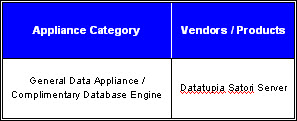 Dataupia’s flagship product, Satori Server is a data warehouse appliance in the sense that it combines software and hardware components on a rack-mounted server hardware. Additionally, Satori Server includes an embedded copy of the Linux operating system, a custom database engine, an aggregation engine, built-in storage, and parallel processors. But in contrast to full data warehouse appliances that are purpose-built for data warehousing, Satori Server interoperates with existing database management systems rather than requiring their replacement.
Dataupia’s flagship product, Satori Server is a data warehouse appliance in the sense that it combines software and hardware components on a rack-mounted server hardware. Additionally, Satori Server includes an embedded copy of the Linux operating system, a custom database engine, an aggregation engine, built-in storage, and parallel processors. But in contrast to full data warehouse appliances that are purpose-built for data warehousing, Satori Server interoperates with existing database management systems rather than requiring their replacement.
The main feature of Satori Server that makes it unique amongst all data warehouse appliances is “omniversal transparency”. This feature shields applications and users from changes to the underlying technology and database platform by complementing Oracle, MS SQL Server, or DB2 databases and their dependent applications. Unlike other solutions that displace existing technologies, the Satori Server’s innovative design extends and enhances an existing information eco-system. Further, Datatupia’s Satori Server is usually added to an existing data warehouse infrastructure by augmenting an organization’s existing data management systems as a query accelerator or capacity extender.

